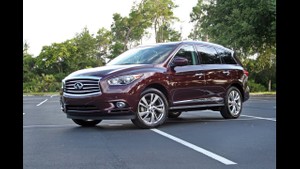2014 infiniti qx70 manual. 2014 Infiniti QX70 Owners Manual 2019-01-14
Infiniti QX70 2014 Service Repair Manual PDF Download

If they are not com- pletely secured, passengers may be injured in an accident or sudden stop. To avoid or reduce the risk, the procedures must be followed precisely. Your child could be seriously injured or killed in a collision if the child restraint top tether strap is damaged. After 30 seconds, the motor reactivates and retracts the seat belt. Failure to follow the warnings and instructions for proper use and installa- tion of child restraints could result in serious injury or death of a child or other passengers in a sudden stop or collision: — The child restraint must be used and installed properly.
Infiniti QX70 (2014) manual

Power lift gate main switch P. Of course, we are perplexed, too. Position the child restraint on the seat. Do not install child restraints that require the use of a top tether strap in seating positions that do not have a top tether anchor. The retractor is designed to lock during a sudden stop or on impact.
2014 Infiniti QX70 Owners Manual PDF

Do not place cargo higher than the seatbacks. The belt should be away from your face and neck, but not falling off your shoulder. If loose parts, deterioration, cuts or other damage on the webbing is found, the entire seat belt assembly should be replaced. Front passenger supplemental air bag P. In an accident, an improperly fitting seat belt could cause serious or fatal injury. Cargo cover if so equipped P.
2014 Infiniti QX70 Owners Manual

Console box — Power outlet P. With this system, you do not have to use a vehicle seat belt to secure the child restraint. Instrument brightness control switch P. Rear window defroster switch P. Position the lap belt portion low and snug on the hips as shown.
Infiniti QX70 2014 Service Repair Manual PDF Download

The reclining feature allows adjustment of the seatback for occupants of different sizes for added comfort and to help obtain proper seat belt fit. Press downward and rearward firmly in the center of the child restraint with your knee to com- press the vehicle seat cushion and seatback while tightening the webbing of the anchor attachments. If the seating position does not have an adjustable head restraint and it is interfering with the proper child re- straint fit, try another seating position or a different child restraint. The child restraints should be replaced if they are damaged. Check the seating surface and buckles before placing a child in the child restraint.
2014 Infiniti QX70 Owners Manual PDF

Hazard warning flasher switch P. The seatback should not be reclined any more than needed for comfort. The lap belt should lie snugly across the lower hips or upper thighs, not the abdo- men. Do not ride in a moving vehicle when the seatback is reclined. Store the head restraint properly in a secure place so it is not loose in the vehicle. If the seatback is reclined, the risk of sliding under the lap belt and being injured is increased. Failure to do so may reduce the effec- tiveness of the entire restraint system and increase the chance or severity of injury in an accident.
2014 Infiniti QX70 Owners Manual

Try to tug it forward and check to see if the belt holds the restraint in place. Front view camera if so equipped P. Remove the head restraint from the seat. Modifying or tampering with the seat belt system may result in serious perso- nal injury. Periodically check to see that the seat belt and the metal components such as buckles, tongues, retractors, flexible wires and anchors work properly. Modification could affect its performance, safety or durability, and may even violate governmental regulations.
Infiniti QX70 (2014) manual

Read more: There are no graphics changes for 2014, with the exception of the new model-name badge. Seat belt assemblies not in use during a collision should also be inspected and replaced if either damage or improper operation is noted. If you see a symbol similar to those above in an illustration, it means the arrow points to the front of the vehicle. Always sit well back in the seat with both feet on the floor and adjust the seat belt properly. To avoid or reduce the risk, the procedures must be followed carefully. If necessary, adjust or remove the head restraint to obtain the correct child restraint fit. Front seat-mounted side-impact sup- plemental air bags P.
2014 Infiniti QX70 Service and Repair Manual

All information, specifications and illustra- tions in this manual are those in effect at the time of printing. Studies show that children are safer when properly restrained in the rear seat than in the front seat. If the motor cannot retract the seat belt when the seat belt is fastened or unfas- Safety — Seats, seat belts and supplemental restraint system 1-13 Page: 34 1-14 Safety — Seats, seat belts and supplemental restraint system tened, it may indicate the pre-crash seat belt system has a malfunction. Hazard that could cause death serious, the procedures must be followed precisely, hazard that could cause minor moderate. The shoulder belt will not be against your body.
Infiniti QX70 2014 Service Repair Manual PDF Download

The power seat motor has an auto-reset overload protection circuit. Your name, address, and telephone number. After attaching the child restraint, test it before you place the child in it. The child restraint will not be secured properly. This helps reduce the risk of injury in a collision. The restraint could tip over or be loose and cause injury to a child in a sudden stop or collision.